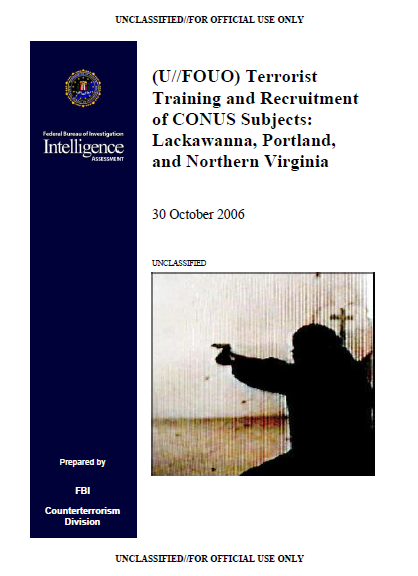FBI Counterterrorism Division
- 12 pages
- For Official Use Only
- October 30, 2006
(U//FOUO) This assessment addresses the Terrorism (TERR) topic of the NIPF and the following FBI International Terrorism intelligence requirements: IT I.B.2-4; IT II.B.1.
(U//FOUO) This assessment addresses the central role of terrorist training in three significant post-9/11 continental United States (CONUS) terrorism investigations: Lackawanna, Portland, and Northern Virginia. This assessment does not address other individuals who may have sought training independently, nor does it address groups of individuals who sought training in regions outside of South or Central Asia.
(U//FOUO) This assessment is not a comprehensive account of terrorist training by CONUS subjects. It compares and contrasts these cases in order to illustrate the various ways CONUS subjects could be drawn into extremist circles and seek terrorist training in the United States and abroad. The information contained in this assessment is primarily derived from FBI case files and open source information and is current as of 25 October 2006.
(U//FOUO) Key Judgments
- (U//FOUO) Assessment of groups involved in the Lackawanna, Northern Virginia, and Portland cases suggests there is no single profile of groups that become involved in terrorist training. However, analysis of FBI case files suggests two broad types: ethnically homogeneous groups composed of individuals connected through familial or community ties, and ethnically heterogeneous groups composed of individuals of various backgrounds, including converts, who are often connected through shared ideology and mosque attendance.
- (U//FOUO) Charismatic leaders, particularly those with prior violent extremist activity abroad, play a key role in the recruitment process.
- (U//FOUO) Recruiters in each case used a variety of rhetorical arguments and ideological justifications to encourage the men to undergo training. Tactics ranged from religious justifications, to criticisms of their non-Islamic lifestyles, to appeals that Muslims worldwide are under siege.
- (U//FOUO) While imams were directly or tangentially involved in all of the investigations, recruitment often took place in private off-site meetings rather than at mosques.
- (U//FOUO) Several of the groups conducted domestic paramilitary training under the tutelage of members with prior military or violent extremist experience.
…
(U) The Recruitment Process
(U//FOUO) Analysis of these cases does not reveal any single recruitment process. Charismatic leaders, however, played a key role in the recruitment process, particularly those with prior experience with violent extremist activity abroad. Such prior experience confers on these individuals a degree of legitimacy and respect that facilitates the recruitment process.
- (U//FOUO) Kamal Derwish, the primary recruiter in the Lackawanna investigation, was born in the United States but moved to Saudi Arabia as a child. He fought in Bosnia and was later arrested in Saudi Arabia for extremist activities before returning to the United States in 1998. In the latter stages of the recruitment process, Derwish introduced potential recruits to former Indiana imam and current Guantanamo Bay detainee Juma al-Dosari, another veteran of the Bosnian conflict. According to one of the Lackawanna subjects, al-Dosari was brought by Derwish to “close the deal” in their recruitment.
- (U//FOUO) According to a joint assessment conducted by the Department of Homeland Security and the FBI, titled The International Children’s Game (23 July 2004), Randall “Ismail” Royer, a convert to Islam and member of the Northern Virginia group, was another veteran of the Bosnian conflict. Royer used contacts developed in Bosnia to arrange for training at Lashkar-e-Tayyiba (LT) camps in Pakistan.
- (U//FOUO) FBI information indicated that Habis al-Saoub, a member of the Portland group, was a veteran of the Soviet-Afghan conflict. Al-Saoub’s stories of the Soviet-Afghan conflict influenced other group members’ decisions to enter Afghanistan for the purpose of fighting Coalition forces.

